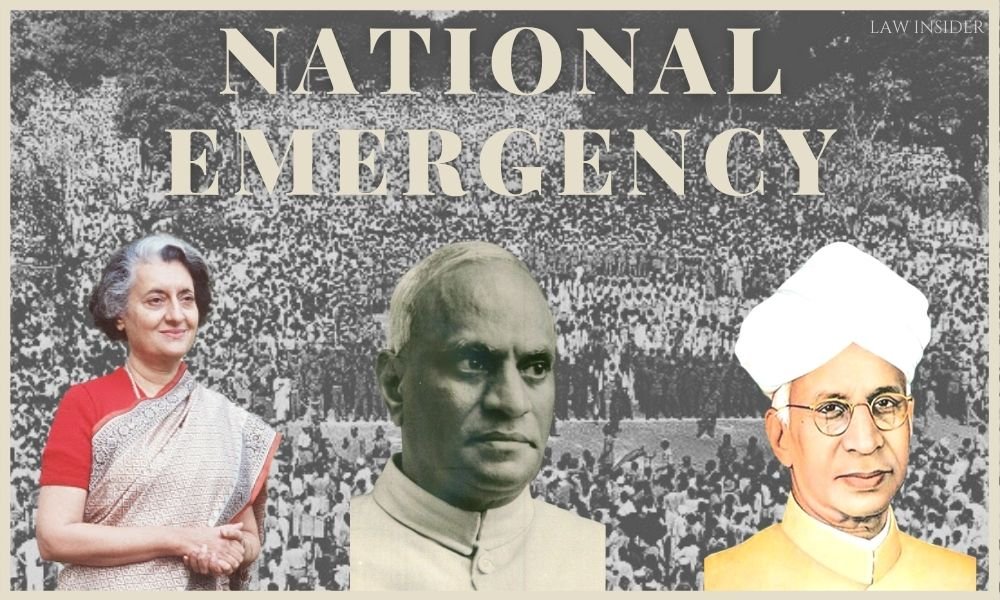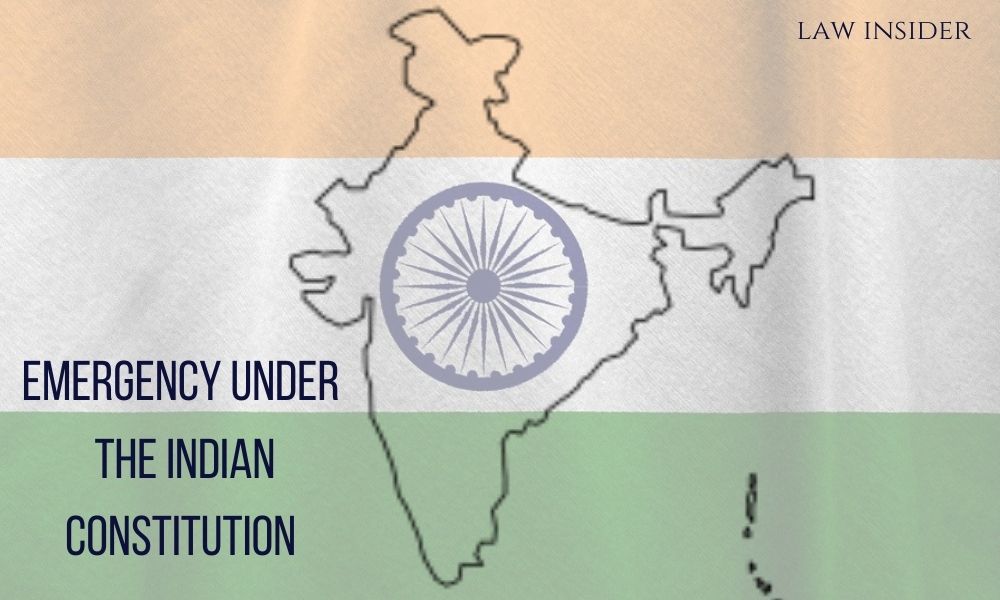Published On: August 28, 2021 19:09 IST
Introduction
“Emergency”, as the word comes in our mind states a matter of fear, panic and even nervousness. But what could happen in the State when such situation is prevalent on the whole country. The makers of the constitution after going through World War-I and World War-II, knew that a provision has to be made to combat such circumstances and protect the nation. It not only includes aggression externally but to maintain it internally also.
Dr. B.R. Ambedkar claimed that Indian federation was unique as during the times of emergency it could convert itself into an entirely unitary system. This means conversion of the system of decentralization of powers to centralization of powers. The concept of emergency was borrowed from Weimar constitution of Germany. In India, the emergency provisions are such that the constitution itself enables the Central Government to acquire the strength of unitary Government whenever the situation demands.
Hence, whenever a situation prevails, the Government of India should use emergency as a last weapon of all methods as it affects India’s federal feature of Government as well as disrupts the validity of some fundamental rights on the citizens including Freedom of Press. Emergency is of three types as provided under Indian constitution:
- National Emergency,
- State Emergency,
- Financial Emergency.
Emergency and the Constitution
As per constitution of India, Part XVII covers the emergency provisions under Article 352 to 360. As we know that India is a federal country of its own kind i.e., Quasi-Federal where it becomes federal and unitary as per the situation prevailing. Generally, Emergency is a situation which arises due to the failure of the Government machinery which causes or demands immediate action from the authority. In Hindi, it is means –Aapaatkaaleen.
There are three types of emergencies mentioned in the constitution. The power of imposing all three types of emergencies is vested upon the president of India. The different types of emergencies are explained under different Articles of the constitution which are as follows:
- Article 352: National Emergency,
- Article 356: State Emergency,
- Article 360: Financial Emergency.
Different emergencies are for different kind of circumstances. If there is war or some external or internal threat to the country, the National Emergency or Proclamation of Emergency is imposed on the whole country which gives Center full power of the country.
At any point if there is any kind of machinery failure of any State of India, an emergency has to be imposed in that particular State till the next elections or if there is threat to security, in such case State emergency can be used by the president. For the case of financial emergency, it is generally used whenever there is any economic threat to the country.
What is National Emergency?
The declaration of National Emergency is mentioned in Article 352[1] of the Indian Constitution that can be done by the president of India in case of security of India or security of any part of the country is threatened or infringed. The imposition of National Emergency is generally called Proclamation of Emergency. There is no particular format present for the president to impose National emergency.
The President for imposing the emergency has to be satisfied that the India’s security is concerned in the situation on certain grounds. The grounds are explained in the Indian Constitution for the cause of declaration of National Emergency. These are three in number and can be explained as follows:
- War
When it is formally declared between two countries that both of them are going to use armed forces against each other, such situation is known as war. Hence, to be in a war an official declaration by both countries is necessary.
- External Aggression
When there is no official declaration of war between two countries but still one of the countries is using armed forces against the other one, this type of circumstances are known as external aggression. It is generally done with the intention of acquiring or destroying the other country.
If Emergency is declared under the above-mentioned grounds or basis, such type of National Emergency is known as External Emergency which can only be imposed by President of India after examination of the whole situation.
- Armed Rebellion
If emergency is imposed under this ground, it is known as Internal Emergency. The term armed rebellion was inserted after 44th amendment of the Indian Constitution. Before it, the term in use was Internal disturbances. Rebellion is generally said to be a violent organized action by a large group of people who are trying to change their country’s political system. If such rebellion is carrying weapons with them can be called Armed Rebellion.
Hence, these are the grounds only on which National Emergency can be declared in India as per the Constitution. The reasons can be both – External as well as Internal.

When and Why National Emergencies have been imposed in India?
National emergency has a lot of short term and long term effects on the country. Till date there have been three times when the National Emergency has been declared in the country that have different causes and effects at the point of time. These have even led to introduction of various amendments.
- First Proclamation of Emergency (October 1962-January 1968)
Reason: The reason for initiation of the following emergency was the China Attack. The president has proclaimed the National Emergency under Article 352 of the Constitution on the ground of External Aggression. In this, the president has suspended all fundamental rights including Article 21 and 22. Even no citizen was allowed to go to the courts for enforcing their fundamental rights.
Effects: Members of previous parties and leaders of opposition were arrested on the basis that their activities are against the national interest. On November 21st, 1962 our clashes with China ended but the emergency was continued to 1965.
Tashkent Agreement: In April 1965, India got under an armed conflict with Pakistan which turned into a war in September 1965. In January 1966, cease fire started which lead an agreement between both countries called Tashkent agreement.
But even after end of both wars, the emergency continued.
Revocation: The public was agitated because of misuse of the emergency leading to public campaigns and appeals. Even international focus was concerned which led the Government to revoke the first emergency.
- 2nd Proclamation of Emergency (December 3rd, 1971)
Reasons: The main reason was the armed conflicts between India and Pakistan. With its beginning the Parliament of the country has adopted the Maintenance of Security Act (MISA), COFE, POSA and Government defense of India Rules for preventive detention and gave tremendous powers to the central Government even after emergency.
Effects: Huge misuse of powers was started leading to various custodial deaths, arrests and increased encounters. The emergency continued even after end of the war. Also, in 1974, the president said that for the security of the country, citizens are not allowed to go to the courts for the enforcement of their fundamental rights.
Revocation: This emergency was never revoked officially. In July 1975, the 3rd emergency was declared before any revocation of 2nd emergency.
- 3rd Proclamation of Emergency (June 25th 1975- March 23rd 1977)
Reasons: In June 1975, the president of India declared National Emergency under Article 352 on the ground of Internal Disturbances. Before the proclamation, Allahabad High Court has found Indira Gandhi[2] guilty for Corrupt Practices under an Election Petition. Due to which High Court has disqualified her from her public offices and ordered not to assume any public office in the coming six years. Indira Gandhi appealed in Supreme Court, but Supreme Court was on vacation at that time and she was granted only conditional stay.
Opposition started demanding her resignation and public demonstrations spread all over the country. It was most restrictive emergency in the Indian history.
Effects: Various Constitutional Amendments were brought tremendously and fundamental rights were curtailed. Opposition leaders and other opponents were arrested with full censorship on Press. Insensitive and Tyrant Government programme’s prevailed like- Slum Clearance, Family Planning etc.
Change in Power of President: In case of emergency, the power of the president was made Final and Conclusive i.e., which could not be challenged.
Revocation: This tyrant emergency was at last revoked on March 23rd, 1977.
What is the Process of Approval and Revocation of Emergency?
The process of approval initiates from the Cabinet of Ministers. If the Cabinet that includes Council of Ministers and the Prime Minister gets satisfied from the grounds mentioned in Article 352 of the Constitution for the existence of the emergency, they pass a written advice to the President considering the issue of emergency. The second step includes that if the President is satisfied from the written advice of Cabinet, then he declares or proclaim the emergency.
But the continuation or revocation of an emergency is decided by the Parliament of the country. Hence, after the declaration of National Emergency by the President the proclamation goes in the hands of Parliament for the further approval. Parliamentary approval is considered when both houses of Parliament pass the Emergency by Special Majority. For Special Majority, there are mainly two requirements:
- 50% of the total strength of the house,
- 2/3rd members present and voting.
The condition of Special Majority was included in 44th Amendment and before the following, the Parliament used Simple Majority.
The validity of an emergency lasts up to 6 months only. Generally, am emergency can be continued till definite time, it is Parliamentary approval that is needed to be renewed after six months. If it is to be continued even after 6 months the whole above-mentioned process has to be performed again.
In case, if only one house approves for the emergency or both houses refused the emergency, it can exist for only one month. The revocation of the National Emergency can be done by two ways:
- If President thinks that the grounds on which emergency was declared do not exist anymore, he can at the same time revoke it.
- If Lok Sabha passes a decision showing disapproval, the emergency has to be revoked at the same time.
Conclusion
As we have seen in the whole historical background of the National Emergency, it has always led to mass destruction and fatal consequences. In emergency, Center gets more powerful, and the powers of State Government gets shifted towards the Central Government. Even it is well established that during emergency, the fundamental rights of the citizens are curtailed.
Article 358 states that in emergency, the freedoms given under Article 19 are automatically suspended. But as per 44th amendment, Article 19 can only be suspended in case of War and External Aggression. Article 359 gives power to the president to suspend other fundamental rights also if needed. But only Article 20 and Article 21 are not affected at all. This was also adjusted after 44th Amendment.
Since, there are a lot of bad consequences and effects can be seen including misuse of powers, curtailment of Fundamental Rights, the National Emergency should only be use at verge or as a last weapon of the Government to handle any situation.
Reference
[1] Emergency Provisions, available at: drishtiias.com (Last visited on August 25th, 2021)
[2] JOYDEEP BOSE, “June 25: On this day in 1975, Indira Gandhi imposed the Emergency. What remains of its legacy?” available at: hindustantimes.com (Last visited on August 25th,2021)

